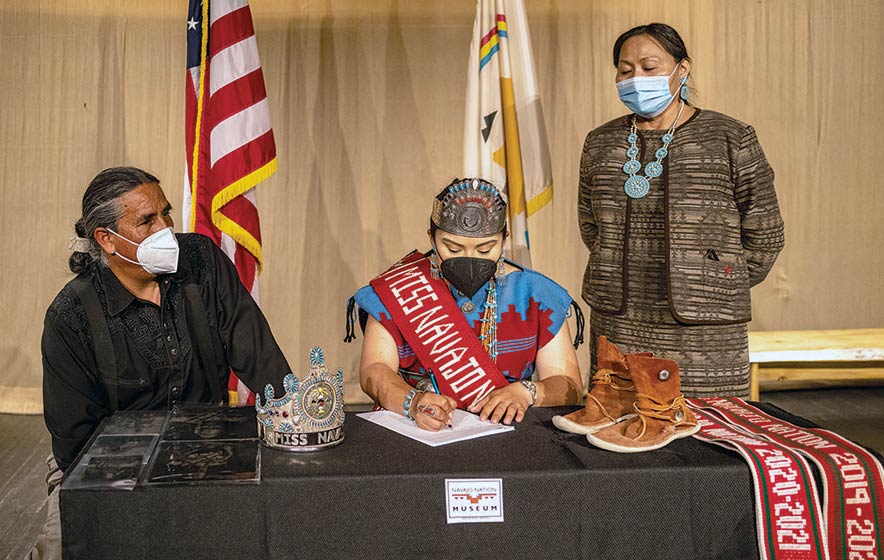
Preserving history: Miss Navajo donates items to museum

Sharon Chischilly | Navajo Times
Manuelito Wheeler, director of Navajo Nation Museum, and Miss Navajo office Director Carletta Benally join Miss Navajo Nation Shaandiin Parrish, middle, Friday at the museum in Window Rock. Parrish donated a pair of moccasins, two original Miss Navajo Nation sash belts, black glass portraits, and the 2016 Miss Navajo Nation crown.
DÁ’DEESTŁ’IN HÓTSAA
She wanted only to win the “best butcher” title that year – but she achieved more than expected.
Shaandiin Paul Parrish won the best butcher, miss photogenic, people’s choice, miss congeniality and the coveted Naabeehó Bich’eekį’ crown, becoming the 2019-20 titleholder, on Sept. 7, 2019.
Parrish, who competed for the title when she was 25, said she didn’t expect to be Miss Navajo Nation for two years and four days because of the pandemic.
“I just wanted to be the best butcher and that was my only goal,” Parrish said. “I watched the pageant and so many teachings and lessons go into each individual as a young lady.
“And I’ve always seen our pageants as a way to retain our language, our culture, our way of life,” she said.
Parrish said her role as Miss Navajo helped her absorb Diné culture and her knowledge is what she will pass to her younger sisters and to the next generation of young Diné men and women in her family.
“That was my mindset before the pageant,” Parrish said. “It was very unexpected. It was a huge change for my life.”
Parrish is now 27 years old. She’s the daughter of Timothy “TJ” Begay and Shelly Parrish.
She’s originally from Tódinéeshzhee’ and the Naatsis’áán, Arizona, areas.
She is Kinyaa’áanii and born for Kinyaa’áanii. Her maternal grandfather is Tódích’íi’nii, and her paternal grandfather is Tábąąhá.
Miss Navajo showcase
Parrish and Carletta Benally, director of the Office of Miss Navajo Nation, on Friday morning donated momentos of her reign to the Navajo Nation Museum.
She donated her original title sashes (2019-20 and 2020-21), the pair of moccasins she wore during the year of the president’s COVID-19 food distributions, and a collection of tintype and black glass ambrotype portraits of her.
“The reason why I decided to donate both of my original sashes is because I truly believe that my time as Miss Navajo Nation has been to our people’s end,” Parrish said.
Parrish said if she could pass her sashes to her younger sisters or one of the young women in her family, she would. But the sashes would be best preserved in the museum for current and future generations.
“I have two of them and I definitely want them to stay together,” Parrish said. “My time and energy and resources – everything, even my sashes, are of services to the Navajo Nation.”
Navajo Nation Museum Director Manuelito Wheeler said only three Miss Navajo Nation crowns have been donated to the museum.
He said Parrish is the first Miss Navajo to donate personal items.
The 2016 Miss Navajo Nation crown – worn by Alyson Shirley, Ronda Joe and Crystal Littleben – also was donated to the museum on Friday. Shirley and Littleben each wore the 2016 crown for a short time during their reigns.
The crown was created by itsidí Tommy and Marilyn Lowe from Lók’aa’ch’égai.
“We decided to donate it to the Navajo Nation Museum to preserve the crown,” Parrish said. “We believe that the Navajo Nation Museum is the safest place for the crown.
“And, of course, we want to ensure that it’s preserved over time because ultimately it belongs to the Navajo people,” she said.
Parrish said the museum is also the best place to display the crown and record the life of Miss Navajo to share the lessons of the global pandemic and to help inspire, connect and empower young Diné women.
Sis łichíí
A Miss Navajo Nation sash is a treasure, one that a titleholder can hold on to for a lifetime.
The sash banner, the most sought-after prize in this prestigious pageant, is a sis łichíí’ made with the traditional łichíí’, łigaii, and tátł’idgo dootł’izh wool – colors that represent nááts’íílid. The fringes symbolize nááłtą́ and niłtsą.
Parrish’s 2019-20 sash was woven by Tavish Brown from Nahashch’idí.
Parrish said she didn’t decorate her sash the first year.
The 2020-21 sash was woven by Marie Nez-Gamble from Tónaneesdizí.
Gamble also gifted Parrish with a replica 2019-20 sash, which has her name on it. Gamble is also working on a replica 2020-21 sash for Parrish.
“Miss Navajo is actually a governmental position in the Navajo Nation government,” Parrish explained. “So your personal action form, the PAF, says you’re a Navajo Nation employee. So, technically I was Miss Navajo for two years instead of a combined one term.
“Physically,” she said, “that’s what the sashes represent: two separate years as Miss Navajo Nation.”
Parrish said instead of wearing two sashes at future events, she’ll wear a 2019-21 sash banner.
“It’s a very powerful image,” Parrish said. “In some of the tintypes, I take a picture with both my sashes and to see both of them side by side, it’s very powerful.”
New kélchí
Parrish, who initially wore kénitsaai at the beginning of her reign, decided to get new kélchí in early 2020, around the time the coronavirus entered the U.S. and talks on food distributions started in the president’s office.
“Traditionally, a lot of our women wore (kélchí), just going back to our original moccasins, plain and basic,” Parrish explained. “I decided to get a new pair for the summer, and it was kind of intentional to get a new pair before the food distributions because I wanted to see how worn out they would be by the end.
“I was curious,” she said.
Her kélchí, which were gifted to her by her grandmother, Wanda Smallcanyon Parrish, were well worn by the end of 2020. The soles were worn down and one side is studded with a hole.
“By the end, the (soles) were very, very thin,” Parrish said. “The right side has a hole in it. It’s a pretty big hole. And I didn’t realize there was a hole in it until November (2020), around the time I was collecting voter registration.
“I think it was in Chilchinbeto and I stepped on a rock,” she said, “and I felt the rock and I couldn’t believe that. It had gone through my (moccasin).’
19th century technique
A historic photography method tells the story of the Miss Navajo who didn’t let a pandemic slow her down.
The portraits she donated on Friday seem to be historic photographs, but they are contemporary tintypes and ambrotypes, which are made on a thin iron plate and developed on a glass plate, respectively.
Parrish said the reason she chose to donate these portraits – taken by tintype photographer Eric Retterbush from Kinłání – is because the processes are meant to hermetically seal the images as a preservation method, meaning the photographs hold their place in time.
“If I donated a print from Walmart, that would be affected by the light,” Parrish explained. “Black glass and tintype aren’t affected by the exposure of UV (ultraviolet) rays. So, they’ll last a lot longer than digital print.
“When you see those really old black-and-white images of Sitting Bull and Geronimo, they’re black glass and tintype,” Parrish added. “So, I knew that if those images lasted that long and whoever can do that today, those images will last a lot longer than I’ll be here.”
Parrish has a collection of 22 tintypes and ambrotypes. She donated eight of them to tell the story of the Nation’s struggle, courage and resilience against the coronavirus.
As a public service, the Navajo Times is making all coverage of the coronavirus pandemic fully available on its website. Please support the Times by subscribing.
How to protect yourself and others.
Why masks work. Which masks are best.
Resources for coronavirus assistance








 Highway 264,
Highway 264, I-40, WB @ Winslow
I-40, WB @ Winslow